The history behind Apothicom
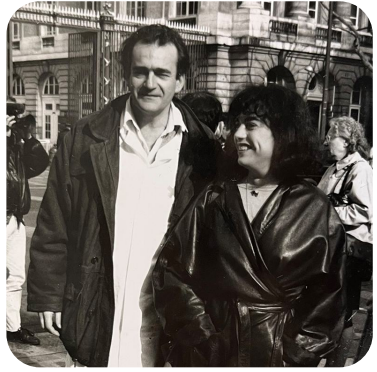 Dr Elliot Imbert and Dr Marie-Christine Charansonnet in 1996
Dr Elliot Imbert and Dr Marie-Christine Charansonnet in 1996The militant initiative that led to the advent of "harm reduction"
In 1982, Dr Elliot Imbert , Dr Marie-Christine Charansonnet, and a group of fellow doctors from a municipal health centre near Paris, France, set up a free and anonymous consultation intended for people who inject drugs. In 1986, they began offering free HIV screening tests. 60% of them were found to be positive.
At that time in France, every day, 10 people who used drugs via intravenous injection were contaminated with the AIDS virus, and even more contracted hepatitis C.
It became urgent to stop the sharing of syringes, and to make clean syringes available to people who inject drugs. A significant obstacle was removed in 1987 with the legalisation of syringe sales in pharmacies, which, until this point, could only be issued upon presentation of a prescription and only to persons over 18 years of age.
In spite of such progress, harmful practices persisted.
There was much work to be done, between discovering and comprehending these clandestine practices, and identifying their connection with often precarious environments. A great number of charitable associations cooperated to work on this issue.
 Dr Elliot Imbert and Dr Marie-Christine Charansonnet in 1996
Dr Elliot Imbert and Dr Marie-Christine Charansonnet in 1996 Dr Elliot Imbert and Dr Marie-Christine Charansonnet at the Ivry-sur-Seine Healthcare Centre
Dr Elliot Imbert and Dr Marie-Christine Charansonnet at the Ivry-sur-Seine Healthcare CentrePhoto © Pierre Daguzon / Magazine Ivry ma ville"
 Dr Elliot Imbert and Dr Marie-Christine Charansonnet at the Ivry-sur-Seine Healthcare Centre
Dr Elliot Imbert and Dr Marie-Christine Charansonnet at the Ivry-sur-Seine Healthcare CentrePhoto credit © Pierre Daguzon / Ivry ma ville" magazine
The creation of Apothicom
Through this municipal health centre, doctors teamed up with drug users and founded Apothicom – the Association for Prevention, Pharmacovigilance and Communication – in 1992.
Alongside community-healthcare networks specialising in the management of HIV and the militant associations AIDES and ASUD, its founders observed that users were commonly making use of household objects as their injection equipment. These objects were diverted from their initial purpose: spoons or drink cans were repurposed to prepare mixtures; the wrong types of syringes were used; cigarette filters or cotton balls replaced sterile cotton filters; and lemon juice, vinegar, and tap or non-drinking water served to dissolve substances. Moreover, these objects were often shared between users. Techniques spread empirically between peers, in the spirit of secrecy usually related to drug use. All these practices contributed to ever-more infectious contaminations.
The Apothicom team rapidly realised that no actions against these harmful behaviours would be effective without proposing new, safe, single-use, and sterile devices, which did not exist in France at this point. They needed to be invented and manufactured. They also needed to be specifically designed for the injection of drugs. Then they needed to be made accessible to as many people as possible.
At the time, this was unthinkable for the pharmaceutical industry. No laboratories wanted to manufacture and market devices intended for illicit practices.
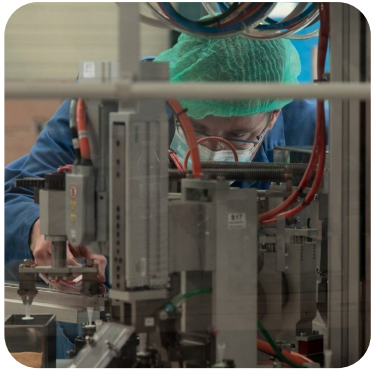 Automation of the Sterifilt production processes
Automation of the Sterifilt production processesThe invention of devices for injection
With the support of a few partners, Dr Elliot Imbert developed the first Steribox® injection kit, which contained syringes, vials of sterile water, alcohol swabs, and condoms. The kit was made available throughout France in 1994 and funded by the French State in 1996, which is still the case today.
The next step was to design and manufacture specific devices for the key stages of preparing and filtering the mixture to be injected.
By analysing drug users' practices, the Apothicom team realised that the cooker needed to be small in order to limit the preparation to a single dose, and that it had to be composed of an inert heat-resistant material.
Apothicom then designed a 10 µm membrane filter in order to limit venous damage related to the injection itself. This filter made it possible to more effectively eliminate dangerous particles, such as cutting agents from street drugs and medication excipients. It is compatible with all syringes, including fixed needle syringes.
After several phases of R&D, the first Sterifilt was created, and has been distributed since 2004.
The manufacturing processes for these new devices were gradually established thanks to large investments in the development of production machinery.
 Automation of the Sterifilt production processes
Automation of the Sterifilt production processes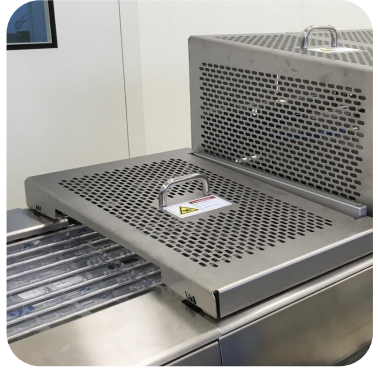 Preparation of the equipment prior to sterilisation
Preparation of the equipment prior to sterilisation Preparation of the equipment prior to sterilisation
Preparation of the equipment prior to sterilisationBusiness growth and the creation of Apothicom Distribution
Large-scale studies showed that viral transmissions were decreasing thanks to the mass distribution of suitable equipment, serving as proof that users will protect themselves if given the means to do so.
Harm reduction programmes in other countries began to express interest in the equipment designed by Apothicom. Many foreign healthcare authorities performed assessments and called on Apothicom's know-how. In view of the association's growth, the company Apothicom Distribution was created in 2008.
Apothicom's expertise facilitates its collaboration with many different types of organisations, ranging from other associations (with which needle and syringe programmes are implemented) to governmental and non-governmental bodies, as well as medical equipment distributors, both in Europe and worldwide.
Apothicom was thus able to expand its range of products to offer additional equipment in the context of its needle and syringe programmes, thanks to the needles, syringes, and tourniquets in its catalogue.
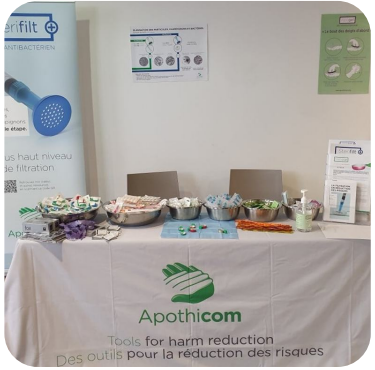 Apothicom presenting the Sterifilt+ at a harm reduction conference in 2022
Apothicom presenting the Sterifilt+ at a harm reduction conference in 2022New innovative devices
Apothicom's focus on real-world situations allowed for constant innovations, making it possible to provide drug users with new devices
For example, the injection of crushed pills – a practice that had been on the rise for around 15 years at this point – indicated the need to develop larger cookers to facilitate preparations.
So it is that the Maxicup was developed, offering a cooker with double the capacity of the Stericup. A built-in handle was added to both the Stericup, and Maxicup in 2019, offering better stability.
The injection of crushed pills also requires the use of more resistant, anti-clogging filters. Apothicom Distribution therefore developed 2 new membrane filters:
• Sterifilt FAST, in 2020, which allows for the rapid filtration of crushed pills.
• Sterifilt+, in 2021, which eliminates bacteria thanks to its 0.22 µm membrane.
Single-use sterile cookers and filters are considered medical devices in Europe. Apothicom's devices are now distributed through needle and syringe programmes and across safe injection facilities in over 20 countries.
 Apothicom presenting the Sterifilt+ at a harm reduction conference in 2022
Apothicom presenting the Sterifilt+ at a harm reduction conference in 2022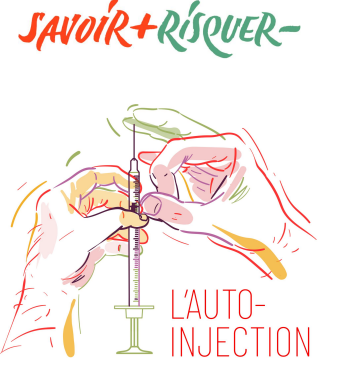
Creation of the Savoir + Risquer - Research Fund
Dedicated to research and training, this non-profit organisation operates like a foundation thanks to its endowment fund. Savoir + Risquer - (Know More, Risk Less) serves the public interest in the field of harm reduction, and helps other non-profit organisations to do the same.
It conducts scientific studies, experiments, and action research while also supporting further research into innovative injection practices and producing guides for both professionals and people who inject drugs. It also provides training on safe injection protocols for professionals in the context of needle and syringe programmes.
Part of Apothicom Distribution's income is allocated to this fund.
Find out more about Savoir + Risquer -